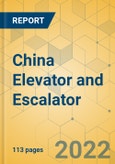Speak directly to the analyst to clarify any post sales queries you may have.
China Elevator and Escalator market by new installations sales is expected to grow at a CAGR of 5.45% during the forecast period (2022-2028).
KEY HIGHLIGHTS IN THE REPORT
- In 2019, over 82% of all elevators installed in China were less than or equal to ten years old.
- According to KONE, by 2025, 65% of all elevators installed would be less than ten years old, resulting in increased demand for new installations of elevators.
- According to the World Economic Forum, more than 500 smart cities are built around China. For instance, the Cloud Valley project launched in April 2021 with a 13 million square feet area that uses Wi-Fi-connected devices and sensors to gather data on everything from people's food habits to pollution.
- China remains a net exporter despite increasing domestic demand. China accounted for 63% of the total elevator new installations market in 2020, followed by Europe, Middle East & Africa.
- Major regions in terms of residential development plus new rail lines & subways are three urban mega-clusters with a lot of growth in the satellite cities around the Beijing-Hebei region and the regions around Shanghai and the Pearl River Delta. Most Chinese provinces still have a very low elevator & escalator density ratio, including several relatively wealthy areas with dense populations. Hence, the pacing regions offer scope for overall density growth in the country.
Due to rapid urbanization, the demand for housing is bound to increase over the forecast period. Governmental initiatives of collaborating with financial institutions to roll out a rent-to-own program are one of the driving forces in demand for housing in the future.
The government started a "build, reconstruct, renovate, and revitalize" program to support lower-income class buyers. Government plans to build 300,000 affordable rental homes by 2025, with around 60,000 completed by 2022. The China government allocated USD 23.6 billion for housing development in the 2021 budget plan.
CHINA ELEVATOR AND ESCALATOR MARKET SEGMENTATION
Segmentation by Type
- Hydraulic and Pneumatic
- Machine Room Traction
- Machine Room Less Traction
- Others
Segmentation by carriage Type
- Passenger
- Freight
Segmentation by Person
- 16-24 Persons
- 25-33 Persons
- 34 Persons and Above
Segmentation by End-User
- Commercial
- Residential
- Industrial and Others
VENDOR ANALYSIS
- The key players in China Elevator & Escalator market are KONE, Otis, Hyundai Elevator, TK Elevator, Mitsubishi Electric, Hitachi, Schindler, Fujitec, and CANNY Elevator Co.
- KONE, Otis, Mitsubishi Electric, and Hitachi are market leaders, accounting for nearly ~57% of the overall China elevator and escalator market share in 2021.
- The market is fragmented in China as both the big OEMs and smaller competitors are active.
Key Vendors
- KONE
- Mitsubishi Electric
- TK Elevator
- Hitachi
- Hyundai Elevator
- Otis
- Fujitec
- Schindler
- CANNY Elevator Co., Ltd.
Other Prominent Vendors
- Kunshan Hualong Elevator
- SJEC
- Analogue Holdings (ATAL)
- SUZHOU JIUDE ELECTRICAL & MECHANIC TECHNOLOGY
- SHENYANG YUANDA INTELLECTUAL INDUSTRY
- IFE ELEVATORS
Table of Contents
Companies Mentioned
- KONE
- Mitsubishi Electric
- TK Elevator
- Hitachi
- Hyundai Elevator
- Otis
- Fujitec
- Schindler
- CANNY Elevator Co., Ltd.
- Kunshan Hualong Elevator
- SJEC
- Analogue Holdings (ATAL)
- SUZHOU JIUDE ELECTRICAL & MECHANIC TECHNOLOGY
- SHENYANG YUANDA INTELLECTUAL INDUSTRY
- IFE ELEVATORS
Methodology
Our research comprises a mix of primary and secondary research. The secondary research sources that are typically referred to include, but are not limited to, company websites, annual reports, financial reports, company pipeline charts, broker reports, investor presentations and SEC filings, journals and conferences, internal proprietary databases, news articles, press releases, and webcasts specific to the companies operating in any given market.
Primary research involves email interactions with the industry participants across major geographies. The participants who typically take part in such a process include, but are not limited to, CEOs, VPs, business development managers, market intelligence managers, and national sales managers. We primarily rely on internal research work and internal databases that we have populated over the years. We cross-verify our secondary research findings with the primary respondents participating in the study.

LOADING...








